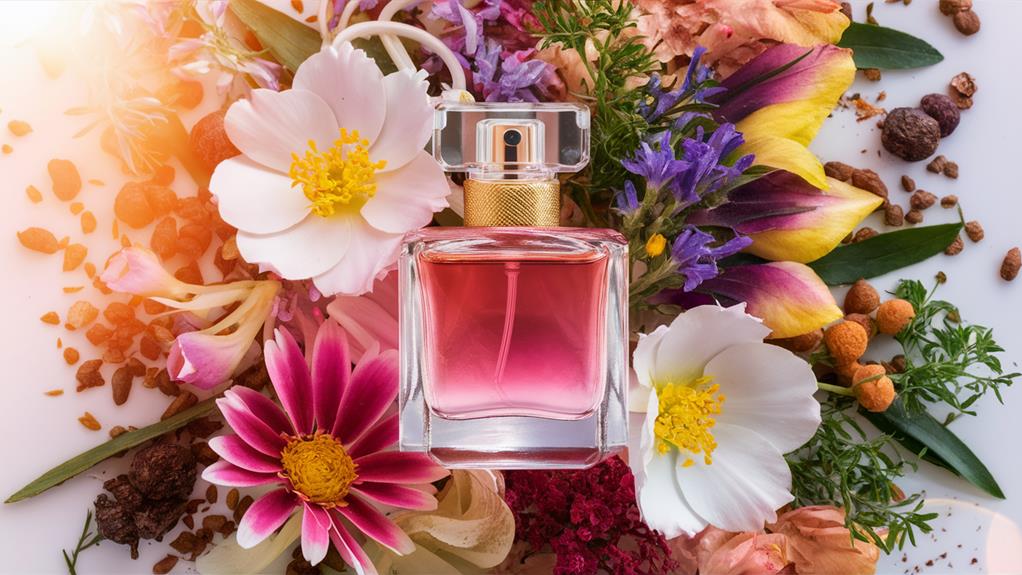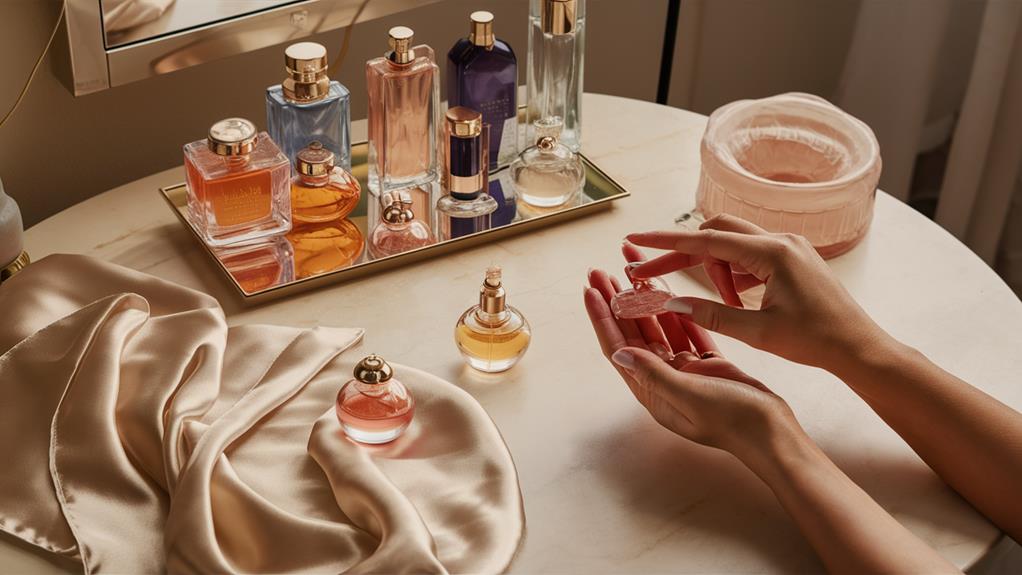To layer perfumes like a pro, start by choosing complementary scents from different families, ensuring balance. Pair a bold fragrance with a lighter one for harmony. Next, understand the fragrance notes: top notes offer initial freshness, middle notes add character, and base notes provide depth. Apply scents in the right order—begin with the most concentrated scent on pulse points and finish with lighter fragrances. Let each layer settle before adding more. This method creates a unique blend that enhances your personal style. Keep exploring to discover even more ways to master the art of fragrance layering.
Key Takeaways
- Choose complementary scents from different fragrance families to create a balanced and inviting blend.
- Start with the most concentrated scent as a base, then layer lighter fragrances for a harmonious effect.
- Apply fragrances on pulse points where body heat can enhance longevity and projection.
- Allow each layer to settle for a few moments before adding another scent to achieve a cohesive profile.
- Consider fragrance notes and their interactions over time to ensure a personalized and non-overpowering scent experience.
Choose Complementary Scents

When layering perfumes, selecting complementary scents is crucial for creating a harmonious fragrance profile. Start by exploring different scent families—floral, woody, citrus, or oriental. Each family has its unique characteristics, and understanding these can help you make informed choices. For example, if you love the freshness of citrus, consider pairing it with a soft floral to balance the vibrancy.
Additionally, you might find inspiration from ultimate tech gifts that enhance your fragrance experience, such as smart fragrance diffusers.
Next, think about fragrance intensity. You want to layer scents that harmonize without overpowering one another. If you've got a bold, spicy perfume, pair it with a lighter, more subtle scent from the same family to maintain balance. This way, the overall effect remains inviting without overwhelming your senses or those around you.
As you experiment, don't hesitate to play with proportions. Start with a light spritz of your base scent, then gradually add the complementary fragrance. This approach allows you to control the intensity and guarantees that you achieve your desired result.
Understand Fragrance Notes

Understanding fragrance notes is fundamental for anyone looking to layer perfumes effectively. Fragrance notes are the building blocks of any scent, and they fall into three categories: top, middle, and base notes. Each plays a significant role in the overall experience of the fragrance.
Top notes are the first impression; they're light and often citrusy, providing an initial burst of freshness. Middle notes, or heart notes, develop after the top notes fade, and they create the fragrance's core character. Finally, base notes are the foundation, often rich and deep, contributing to the scent longevity.
When layering perfumes, it's important to take into account the fragrance families—floral, oriental, woody, and fresh, to name a few. By mixing scents from complementary fragrance families, you can create a harmonious blend that tells a unique story. For example, pairing a floral middle note with a woody base note can add depth and complexity to your fragrance.
Additionally, just as air purifiers utilize various filter types to enhance air quality, blending different fragrance notes can elevate your scent profile.
As you explore different combinations, pay attention to how the notes interact over time. You want a blend that evolves beautifully, enhancing your personal style rather than overpowering it. Understanding how each note unfolds will help you navigate the nuances of scent layering, ensuring you feel confident in your choices.
Apply in the Right Order

The order in which you apply your fragrances can greatly influence the final scent experience. To layer perfumes like a pro, you'll want to start with the most concentrated scent first—typically a heavier base note or an intense oil. This will anchor your fragrance journey and provide a rich foundation.
Additionally, consider incorporating techniques from powerful suction canisters that enhance cleaning efficiency; just like choosing the right vacuum can elevate your cleaning routine, selecting the right fragrance can elevate your scent experience.
Next, apply a lighter scent, such as an eau de toilette or body mist, which will complement and elevate the deeper notes without overpowering them.
When using application techniques, consider your pulse points—areas like your wrists, neck, and behind your ears—where your body heat will enhance the fragrance. A small spritz in these spots can appreciably improve scent longevity.
It's also a good idea to apply your fragrances on moisturized skin. This helps lock in the scent and creates a smoother, more cohesive blend.
Remember to give each layer a moment to settle before adding another. This lets the fragrances mingle and develop, resulting in a harmonious scent profile.
Trust your instincts; if something feels off, you can always adjust by adding more of one layer or toning down another.
Frequently Asked Questions
Can I Layer Perfumes From Different Brands?
Absolutely, you can layer perfumes from different brands!
Just keep fragrance compatibility in mind to avoid clashing scents. Start with a lighter fragrance as your base, then add a more intense scent to create depth.
This way, you'll balance the scent intensity and craft a unique aroma that reflects your personality.
Don't be afraid to experiment; finding your signature blend can give you a sense of belonging in the world of scents!
How Long Do Layered Scents Typically Last?
Did you know that layered scents can last up to 8 hours or more?
When you layer perfumes, scent longevity often increases, thanks to the combination enhancing fragrance intensity. The base notes tend to linger longer, while the top notes offer a fresh burst initially.
You'll find that the blend creates a unique aroma that evolves throughout the day, making you feel special and confident as you embrace your distinctive scent journey.
What Are Some Popular Scent Combinations to Try?
When exploring popular scent combinations, consider blending floral and woody fragrance families for a balanced aroma.
Try pairing a fresh jasmine with a warm cedarwood; this creates an enchanting contrast.
You might also enjoy mixing citrus and spicy profiles, like zesty bergamot with rich black pepper.
Ultimately, it's all about your personal preferences and the layering techniques you adopt.
Experiment with different combinations to find the perfect scent that truly resonates with you.
Is It Better to Layer Oils or Sprays?
When it comes to layering, you'll find that oils offer a richer, more concentrated fragrance intensity due to their oil consistency.
They tend to last longer on your skin compared to sprays, which can evaporate quickly.
If you want a more subtle scent that's easy to refresh throughout the day, sprays might be the way to go.
Ultimately, it's about what feels right for you and aligns with your personal style.
How Do I Store My Layered Perfumes?
To store your layered perfumes, focus on effective storage techniques that enhance fragrance preservation.
Keep your bottles in a cool, dark place away from direct sunlight and heat, as these elements can degrade the scent.
Use airtight containers to prevent air exposure, which can alter the fragrance over time.
Remember, maintaining a consistent temperature will also help keep your creations vibrant.
Conclusion
Layering perfumes can elevate your scent game, making you unforgettable. Did you know that 30% of people say they remember someone's scent long after they've left? By choosing complementary scents, understanding fragrance notes, and applying them in the right order, you can create a unique signature that speaks to your personality. So, don't hesitate—experiment with layering and let your creativity shine. After all, your scent is an extension of you; make it a memorable one!

